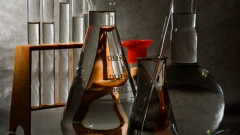Instruction
1
Consider the example of formation of soluble compounds.
Na2SO4 + BaCl2 = BaSO4 + 2NaCl
Or in ionic form:
2Na+ +SO42- +Ba2++ 2Cl- = BaSO4 + 2Na+ + 2Cl-
Na2SO4 + BaCl2 = BaSO4 + 2NaCl
Or in ionic form:
2Na+ +SO42- +Ba2++ 2Cl- = BaSO4 + 2Na+ + 2Cl-
2
Please note that reacted only barium ions and sulfate ions, as other ions has not changed, therefore this equation can be written in abbreviated form:
Ba2+ + SO42- = BaSO4
Ba2+ + SO42- = BaSO4
3
When solving ionic equations, you must observe the following rules:
the same ions from both parts are excluded;
- it should be remembered that the amount of electric charges in the left side of the equation must equal the sum of the electric charges in the right part of the equation.
the same ions from both parts are excluded;
- it should be remembered that the amount of electric charges in the left side of the equation must equal the sum of the electric charges in the right part of the equation.
4
Examples:
To write ionic equations of the reactions of interaction between aqueous solutions of the following substances: a) HCl and NaOH; b) AgNO3 and NaCl; C) К2СО3 and H2SO4; d) CH3COOH and NaOH.
Solution. Write down the equations of the interaction of these substances in molecular form:
a) HCl + NaOH = NaCl + H2O
b) AgNO3 + NaCl = AgCl + NaNO3
C) K2CO3 + H2SO4 = K2SO4 + CO2 + H2O
d) CH3COOH + NaOH = CH3COONa + H2O
To write ionic equations of the reactions of interaction between aqueous solutions of the following substances: a) HCl and NaOH; b) AgNO3 and NaCl; C) К2СО3 and H2SO4; d) CH3COOH and NaOH.
Solution. Write down the equations of the interaction of these substances in molecular form:
a) HCl + NaOH = NaCl + H2O
b) AgNO3 + NaCl = AgCl + NaNO3
C) K2CO3 + H2SO4 = K2SO4 + CO2 + H2O
d) CH3COOH + NaOH = CH3COONa + H2O
5
Note that the interaction of these substances is possible because the result is the binding of ions with the formation of either a weak electrolyte (H2O) or soluble substances (AgCl), or gas (CO2).
6
In the case of variant d), the reaction goes in the direction of greater binding of ions, i.e. the formation of water, although there are two weak electrolyte (acetic acid and water). But this happens because water is a weak electrolyte.
7
Excluding the same ions from the left and right parts of equality (in the case of option (a) ions of sodium and chlorine, in case b) is the sodium ions and nitrate ions, in the case of C) ions of potassium and sulfate ions), g) – sodium ions, get the solution of these ionic equations:
a) H+ + OH- = H2O
b) Ag+ + Cl- = AgCl
C) CO32- + 2H+ = CO2 + H2O
d) CH3COOH + OH- = CH3COO- + H2O
a) H+ + OH- = H2O
b) Ag+ + Cl- = AgCl
C) CO32- + 2H+ = CO2 + H2O
d) CH3COOH + OH- = CH3COO- + H2O

